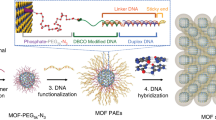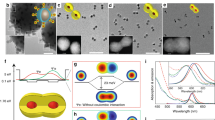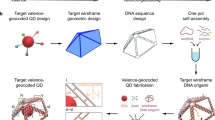Abstract
The electronic and optical properties of colloidal quantum dots, including the wavelengths of light that they can absorb and emit, depend on the size of the quantum dots. These properties have been exploited in a number of applications including optical detection1,2,3, solar energy harvesting4,5 and biological research6,7. Here, we report the self-assembly of quantum dot complexes using cadmium telluride nanocrystals capped with specific sequences of DNA. Quantum dots with between one and five DNA-based binding sites are synthesized and then used as building blocks to create a variety of rationally designed assemblies, including cross-shaped complexes containing three different types of dots. The structure of the complexes is confirmed with transmission electron microscopy, and photophysical studies are used to quantify energy transfer among the constituent components. Through changes in pH, the conformation of the complexes can also be reversibly switched, turning on and off the transfer of energy between the constituent quantum dots.
This is a preview of subscription content, access via your institution
Access options
Subscribe to this journal
Receive 12 print issues and online access
$259.00 per year
only $21.58 per issue
Buy this article
- Purchase on Springer Link
- Instant access to full article PDF
Prices may be subject to local taxes which are calculated during checkout




Similar content being viewed by others
References
Konstantatos, G. et al. Ultrasensitive solution-cast quantum dot photodetectors. Nature 442, 180–183 (2006).
Clifford, J. P. et al. Fast, sensitive and spectrally tuneable colloidal-quantum-dot photodetectors. Nature Nanotech. 4, 40–44 (2009).
Konstantatos, G. & Sargent, E. H. Nanostructured materials for photon detection. Nature Nanotech. 5, 391–400 (2010).
Sargent, E. H. Infrared photovoltaics made by solution processing. Nature Photon. 3, 325–331 (2009).
Huynh, W. U., Dittmer, J. J. & Alivisatos, A. P. Hybrid nanorod–polymer solar cells. Science 295, 2425–2427 (2002).
Michalet, X. et al. Quantum dots for live cells, in vivo imaging, and diagnostics. Science 307, 538–544 (2005).
Gao, X., Cui, Y., Levenson, R. M., Chung, L. W. K. & Nie, S. In vivo cancer targeting and imaging with semiconductor quantum dots. Nature Biotechnol. 22, 969–976 (2004).
Berti, L. & Burley, G. A. Nucleic acid and nucleotide-mediated synthesis of inorganic nanoparticles. Nature Nanotech. 3, 81–87 (2008).
Carter, J. D. & Labean, T. H. Organization of inorganic nanomaterials via programmable DNA self-assembly and peptide molecular recognition. ACS Nano 5, 2200–2205 (2011).
Ma, N., Sargent, E. H. & Kelley, S. O. Biotemplated nanostructures: directed assembly of electronic and optical materials using nanoscale complementarity. J. Mater. Chem. 18, 954–965 (2008).
Nykypanchuk, D., Maye, M. M., van der Lelie, D. & Gang, O. DNA-guided crystallization of colloidal nanoparticles. Nature 451, 549–552 (2008).
Alivasatos, A. P. et al. Organization of ‘nanocrystal molecules' using DNA. Nature 382, 609–611 (1996).
Park, S. Y. et al. DNA-programmable nanoparticle crystallization. Nature 351, 553–556 (2008).
Lee, J. H., Wong, N. Y., Tan, L. H., Wang, Z. & Lu, Y. Controlled alignment of multiple proteins and nanoparticles with nanometer resolution via backbone-modified phosphorothioate DNA and bifunctional linkers. J. Am. Chem. Soc. 132, 8906–8908 (2010).
Mitchell, G. P., Mirkin, C. A. & Letsinger, R. L. Programmed assembly of DNA functionalized quantum dots. J. Am. Chem. Soc. 121, 8122–8123 (1999).
Ho, Y. P., Kung, M. C., Yang, S. & Wang, T-H. Multiplexed hybridization detection with multicolor colocalization of quantum dot nanoprobes. Nano Lett. 5, 1693–1697 (2005).
Zanchet, D., Micheel, C. M., Parak, W. J., Gerion, D. & Alivisatos, A. P. Electrophoretic isolation of discrete Au nanocrystal/DNA conjugates. Nano Lett. 1, 32–35 (2001).
Suzuki, K., Hosokawa, K. & Maeda, M. Controlling the number and positions of oligonucleotides on gold nanoparticle surfaces. J. Am. Chem. Soc. 131, 7518–7519 (2009).
Zhao, W. T. & Hsing, I. M. Facile and rapid manipulation of DNA surface density on gold nanoparticles using mononucleotide-mediated conjugation. Chem. Commun. 46, 1314–1316 (2010).
Ma, N., Yang, J., Stewart, K. M. & Kelley, S. O. DNA-passivated CdS nanocrystals: luminescence, bioimaging, and toxicity profiles. Langmuir 23, 12783–12787 (2007).
Ma, N., Sargent, E. H. & Kelley, S. O. One-step DNA-programmed growth of luminescent and biofunctionalized nanocrystals. Nature Nanotech. 4, 121–125 (2009).
Hinds, S. et al. Nucleotide-directed growth of semiconductor nanocrystals. J. Am. Chem. Soc. 128, 64–65 (2006).
Pecoraro, V. L., Hermes, J. D. & Cleland, W. W. Stability constants of Mg2+ and Cd2+ complexes of adenine nucleotides and thionucleotides and rate constants for formation and dissociation of MgATP and MgADP. Biochemistry 23, 5262–5271 (1984).
Borchert, H. et al, Relations between the photoluminescence efficiency of CdTe nanocrystals and their surface properties revealed by synchrotron XPS. J. Phys. Chem. B 107, 9662–9668 (2003).
Chang, T-W. F. et al. Efficient excitation transfer from polymer to nanocrystals. Appl. Phys. Lett. 84, 4295–4297 (2004).
Burris, S. C., Zhou, Y., Maupin, W. A., Ebelhar, A. J. & Daugherty, M. W. The effect of surface preparation on apparent surface pKas of mercaptocarboxylic acid self-assembled monolayers on polycrystalline gold. J. Phys. Chem. C 112, 6811–6815 (2008).
Fu, A. et al. Discrete nanostructures of quantum dots/Au with DNA, J. Am. Chem. Soc. 126, 10832–10833 (2004).
Wilk, K. E. et al. Evolution of a light-harvesting protein by addition of new subunits and rearrangement of conserved elements: crystal structure of a cryptophyte phycoerythrin at 1.63 Å resolution. Proc. Natl Acad. Sci. USA 96, 8901–8906 (1999).
Wohri, A. B. et al Light-induced structural changes in a photosynthetic reaction center caught by Laue diffraction. Science 328, 630–633 (2010).
Pascal, A. A. et al. Molecular basis of photoprotection and control of photosynthetic light-harvesting. Nature 436, 134–137 (2005).
Acknowledgements
The authors acknowledge support from the National Institutes of Health (R21 to S.O.K.), the Ontario Research Fund (ORF-RE to S.O.K. and E.H.S.) and the Canada Research Chairs programme (E.H.S.).
Author information
Authors and Affiliations
Contributions
G.T. and S.O.K. designed the protocols for the synthesis of the nanoparticles and complexes. S.H., G.T. and E.H.S. designed and interpreted the energy transfer studies. G.T., P.E.L. and A.F. carried out materials analysis, and worked with E.H.S. and S.O.K. in their interpretation. E.H.S. and S.O.K. co-wrote the paper with contributions from G.T., S.H., A.F. and P.E.L.
Corresponding authors
Ethics declarations
Competing interests
The authors declare no competing financial interests.
Supplementary information
Supplementary information
Supplementary information (PDF 2450 kb)
Rights and permissions
About this article
Cite this article
Tikhomirov, G., Hoogland, S., Lee, P. et al. DNA-based programming of quantum dot valency, self-assembly and luminescence. Nature Nanotech 6, 485–490 (2011). https://doi.org/10.1038/nnano.2011.100
Received:
Accepted:
Published:
Issue Date:
DOI: https://doi.org/10.1038/nnano.2011.100
This article is cited by
-
Strong coupling in plasmonic metal nanoparticles
Nano Convergence (2023)
-
Nanoscale 3D spatial addressing and valence control of quantum dots using wireframe DNA origami
Nature Communications (2022)
-
Synthesis and application of stationary phase for DNA-affinity chromatographic analysis of unmodified and antisense oligonucleotide
Analytical and Bioanalytical Chemistry (2021)
-
DNA-Driven Nanoparticle Assemblies for Biosensing and Bioimaging
Topics in Current Chemistry (2020)
-
Highly Sensitive Polarimetric Sensor Based on Fano Resonance for DNA Hybridization Detection
Plasmonics (2020)



